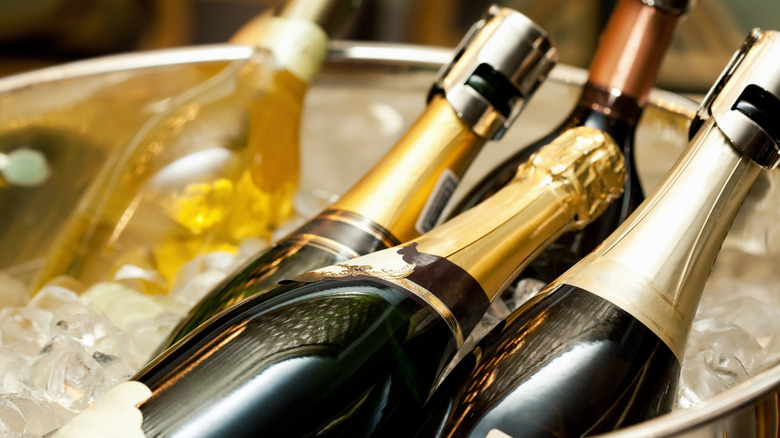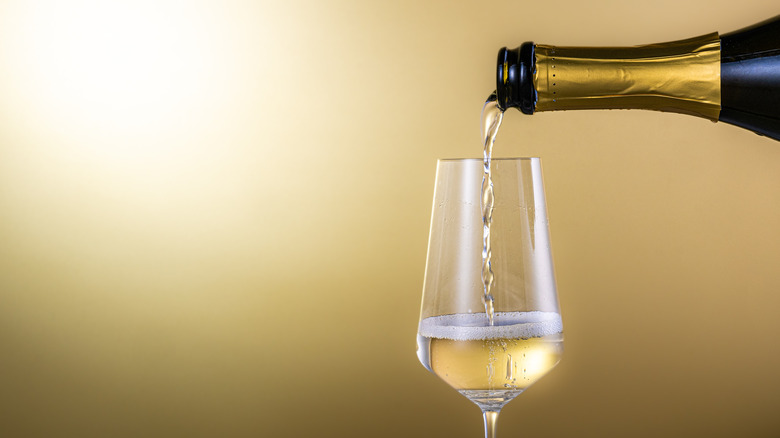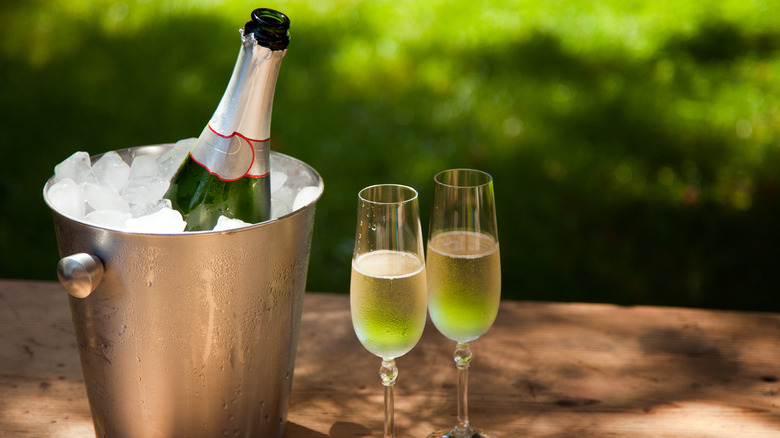How Long An Open Bottle Of Champagne Actually Lasts
There's nothing like that first sip of freshly-opened Champagne, when all those little bubbles cascade into your glass and fizzily pop when they reach your lips. What makes it special is that this degree of intense effervescence is relatively short-lived. Sparkling wines, like all wines, will oxidize over time and become progressively less enjoyable to drink, losing their fizz and flavor until they're not drinkable at all.
How long does this process take? A bottle of Champagne remains drinkable for a few days, with the exact number depending on storage conditions and whether or not you plug the opening of the bottle. There are numerous ways to re-close the bottles once their corks have been popped, from dedicated Champagne stoppers made from a wide variety of materials (like rubber, silicon, or stainless steel) to homemade hacks involving silver spoons, aluminum foil, or plastic wrap.
Temperature also plays a huge part in how long Champagne retains its signature effervescence. The colder you keep your bottle, the better it will retain its fizz, although the bubbles will still escape over time. Proper storage in a cold fridge will keep the wine drinkable for up to five days, in the best case-scenario. Poorly-preserved Champagne, stored in an environment that's too warm with nothing stopping the bubbles from escaping, can go flat in as little as two days.
Keeping Champagne fresh through proper storage
Sticking the handle of a metal spoon in the neck of a Champagne bottle is an old trick to preserve effervescence, but its effectiveness was debunked in 1994 by Stanford chemist Richard Zare. Zare proposes that cold temperatures are what really keep Champagne bubbly for longer. While a metal spoon does get very cold in the fridge, and that may help keep the bubbles intact, the spoon itself is not particularly adept at preserving the wine.
A good bottle stopper will better help to preserve carbon dioxide, the gas responsible for the bubbles in Champagne and other sparkling drinks. However, storage temperature seems to be the most important factor for longer-lasting drinking pleasure. As Zare implores readers in Scientific American, "Keep [Champagne] cold. In fact, never let it warm up. That's the secret."
An effective closure for your Champagne bottle and a very cold refrigerator work in tandem to keep the drink fresh and bubbly for as long as five days, though the wine will be fizzier on day two than it is on day three, and so on. Refrigeration will keep bottles twice as fresh as those stored at room temperature, thanks to the cold's preservative benefits for carbon dioxide, while the stoppers work to keep the gas inside the bottle. Stainless steel or silicone stoppers that promise airtight seals can be found at many stores, but some experts swear by homemade closures made of aluminum foil or plastic wrap. These DIY stoppers not only slow oxidation of Champagne; they also have no risk of causing pressing buildup that makes the drink explode out of the bottle when you open it again.
Quantity also matters for freshness
As any sommelier can tell you, Champagne is sold in a bewildering array of bottle sizes, from single-serving splits to magnums (double the standard size) to the gargantuan Melchizedek, which is equivalent to 40 regularly-sized bottles. We wouldn't recommend buying the latter, as it's unlikely you have a refrigerator big enough to store it, but the sizes of the bottles you do end up buying can influence how long the wine stays fresh and fizzy.
Beyond closing your bottle right and keeping it chilled, size is another major factor in how well Champagne bubbles are preserved. For context, an unopened 3-liter Jeroboam of Champagne has more than triple the shelf life of a normal-sized 750-milliliter bottle (132 years versus 40 years, respectively). This freshness advantage continues even after bottles have been opened.
Research by champagne scientist Gerard Liger-Belair has shown that larger bottles have more carbon dioxide stored inside before opening (via NBC News), and retain a larger percentage of bubbles even after a few glasses have been poured. Because they have a larger concentration of bubbles to begin with, larger bottles will maintain their fizziness for longer than smaller bottles.



